Woman German Scholar Who Became Born Again
Women feature prominently in the gospels and Book of Acts of the Christian New Attestation every bit supporters of Jesus' ministry. The nearly famous of these is Mary Magdalene, virtually likely an upper-class woman of means instead of the prostitute label still wrongly attached to her, but there is likewise Mary and Martha, the sisters of Lazarus, Mary the mother of Jesus, the Woman at the Well in Samaria, the Woman Taken in Adultery, and many others who are referenced warmly at times in the epistles even when women, in full general, are given second-course status.
The first people recorded as seeing the resurrected Christ were women, and women are integral to the get-go Christian community as depicted in the Book of Acts. Jesus himself has nada to say near the equality of the sexes; he seems throughout the gospels to take it equally self-evident that there is cipher inherently superior in either. Saint Paul (l. c. 5 - c. 67 CE), however, and other writers of the epistles which make up the New Attestation, introduced the Christian misogyny which linked women with Eve and the Autumn of Man.
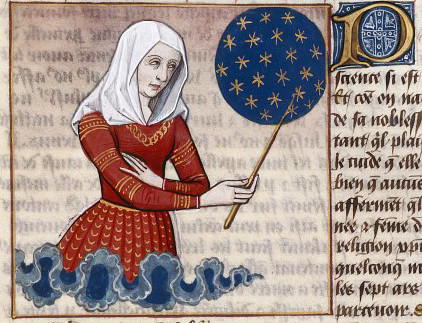
Proba
Eve, as Paul writes, was deceived and so tempted Adam to sin; left to his ain devices, Paul implies, Adam would take remained happily in the Garden of Eden and and so would have all his and Eve's descendants. Women were, therefore, not to be trusted, could non hold authority over men, and should learn from men in silence lest they tempt Adam'south descendants further (I Timothy 2:11-14). Even so, Paul himself seems to echo Jesus' ain view of the equality of the sexes when he writes:
There is neither Jew nor Greek, in that location is neither bond nor free, there is neither male nor female [in Christianity]: for ye are all 1 in Christ Jesus. (Galatians 3:28)
The many other passages from the New Testament, supporting male superiority, were – and yet are – quoted far more ofttimes than the line from Galatians, and women are notwithstanding denied leadership positions in a number of Christian denominations and sects. This was not e'er so, even so, and at that place were many women in the early Church building who held positions of potency, established religious orders, and wrote influential theological works prior to their suppression.
Women in Early Christianity
Anyone with even a cursory noesis of Christianity has heard the term 'Church building Fathers' just far less so 'Church Mothers' – and yet, in the early days of Christianity, women were at the forefront of the organized religion. Roman women were the offset to accept Christianity seriously and in that location are many stories – preserved in the writings of the Church Fathers themselves and in tales of martyrs – of stiff women converting their households to the new religion.
Some of these early Church Mothers embraced Christianity so completely that they gave away any they had – often substantial sums of money and big estates – to help the poor, the ill, and the needy in compliance with Jesus' directive that "Inasmuch as ye accept washed it unto one of the to the lowest degree of these my brethren, ye take done information technology unto me" (Matthew 25:xl). Service to others, especially to those in demand, was service to Christ himself.
The thought for the translation of the Bible to Latin came from a adult female named Paula who not just inspired the piece of work but proofread & edited it for publication.
A number of these women came to be known as Desert Mothers, founders of monastic orders in the deserts of Egypt, Syria, Persia, and Asia Minor. Known as Ammas ('mothers'), they were the female analogue to the better-known Abbas ('fathers') such as Saint Anthony the Great (also known as Saint Anthony of Egypt, 251-356 CE), credited with establishing Christian monasticism. Other women were famous writers who blended pre-Christian literature and philosophy with biblical precepts while still others contributed to edifice projects, social programs, and evangelical efforts while also supporting men whose contributions today are well known.
Any student of the Bible knows that Saint Jerome (l. 347-420 CE) translated the work from Hebrew and Greek to Latin, creating the Vulgate translation which would exist used by the Church for well over the next i,000 years; few people, however, know that the idea for that translation came from a woman named Paula who not simply inspired the work but proofread and edited it for publication.
Shift in Power
Women'due south role in the Church remained more than or less the aforementioned even after Christianity was elevated past Constantine the Great (fifty. 272-337 CE) in 313 CE through his Edict of Milan, which proclaimed tolerance for the new faith. After the Council of Nicaea of 325 CE, however, the state of affairs inverse. Constantine chosen the quango at his villa at Nicaea to standardize Christian conventionalities and practice. The nigh important issue was deciding on Christ's status every bit God, god-man, or prophet simply there were many other aspects of Christianity which were far from uniform. At that place were, in fact, many different versions of the central religious concept of a One True God redeeming the earth.
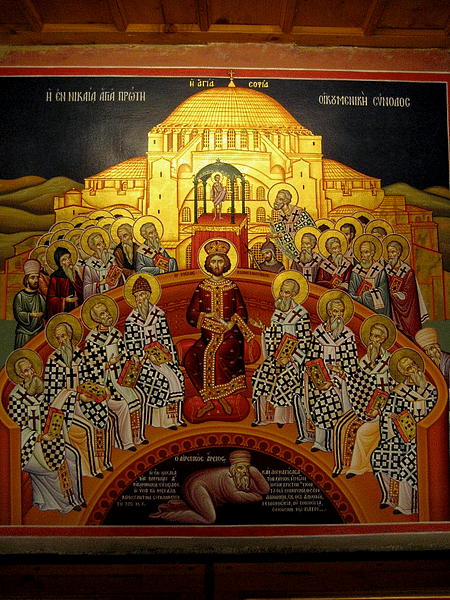
Start Council of Nicaea
While standardizing the Christian vision, Constantine also wanted religious practice to reverberate that uniformity. Pope Clement I (l. c. 35-99 CE) decreed that only men could serve every bit priests or hold potency in the Church because Christ had chosen merely males every bit his apostles. The ecclesiastical writer Eusebius (l. 263-339 CE) records that the council, following Cloudless's lead (and about probable influenced past Paul'south admonitions on female inferiority) decreed women equally laypersons who could serve in subordinate positions but could have no authority over men. Past the fourth dimension of the Council of Nicaea, however, many women had already proven themselves capable and inspiring religious leaders and many more would prove and then going forward.
Ten Should-Be Famous Early Christian Women
The ten women listed here are called from either cease of the spectrum: those whose names might exist familiar to some and those few or none have ever heard of. These ten are simply a very small sample of the many women who contributed to the development of early Christianity and readers are encouraged to explore the subject more fully through the books listed in the bibliography below. The ten women are:
- Thecla the Apostle
- Perpetua the Martyr
- Amma Syncletica of Alexandria
- Saint Marcella
- Macrina the Younger
- Proba
- Saint Paula
- Melania the Elder
- Eudocia
- Egeria
Thecla (1st century CE) is known from the counterfeit work The Acts of Paul and Thecla which narrates her conversion to Christianity by Saint Paul and her subsequent travels with him, divine rescue from various persecutions and decease, and career equally a healer, preacher, and inspiring religious leader. Thecla's story has been regularly dismissed in the by equally Christian fiction, merely modernistic scholars believe that, though there is no doubt some exaggeration of events, the account is based on an actual woman. In his epistles, Paul regularly mentions women who have helped him, and Thecla's story is not so very different from many others save for the repeated miraculous rescues from death. One attribute of her story known to be true of women of her fourth dimension is her vow of chastity, which she kept from her conversion to the cease of her life. Women choosing a chaste life, even if they were married, was a dramatic statement of individuality in challenge rights over their ain bodies and, by extension, over the management of their lives.
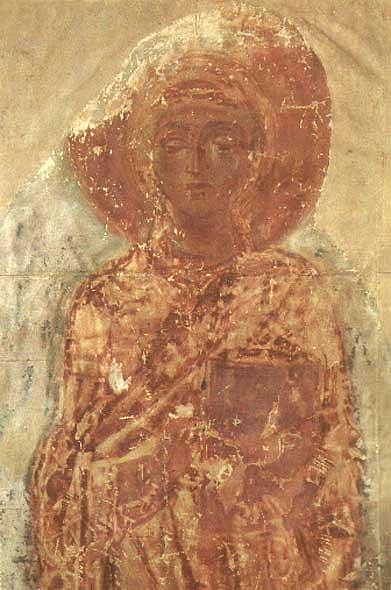
Saint Thecla
Perpetua (l. 181-203 CE) is famous equally an early on Christian martyr who, along with her slave Felicitas, refused to renounce her faith and was executed for information technology. Scholar I. M. Found notes that "in nearly every case, stories of Christian martyrs are fictional…the martyrdom of Perpetua, still, is by and large taken to be an exception to this dominion" (164). A denizen of Carthage, Perpetua was arrested during a persecution of Christians under the Roman emperor Septimus Severus c. 202-203 CE. She was 22 at the fourth dimension and nursing her newborn when she was taken to prison. Her father, a pagan in good standing with authorities, begged her to renounce her faith, simply she refused and was executed along with Felicitas. Based on details of the original narrative apropos motherhood, scholars believe the account was written past a woman – the early part, perhaps, by Perpetua herself – which, as I. 1000. Plant points out, would make her story "the primeval extant Christian literature written past a adult female" (165).
Amma Syncletica of Alexandria (l. c. 270 - c. 350 CE) is i of the best-known Desert Mothers and an early founder of the monastic tradition. Syncletica was the daughter of wealthy parents in Alexandria, Egypt, whose beauty attracted many suitors. She refused them all, however, due to her devotion to Christ. Later her parents' death, she cutting her pilus, gave her inheritance to the poor, and left the urban center with her younger sis (who was blind) to live a life of chastity, poverty, and confinement virtually the crypt of a relative. In solitude, she is said to take wrestled with demons who tried to convince her to resume her previous life of wealth and pleasure, merely she remained truthful to her faith. Having attained the enlightenment and closeness to God she sought, she consented to teach others who sought her out and provided guidelines for this early monastic order of women. These rules, recorded by her biographer (possibly the bishop Athanasius of Alexandria, 50. 296-373 CE), would afterwards influence European monasticism.
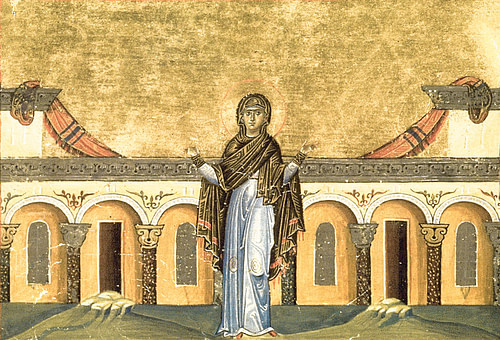
Amma Syncletica of Alexandria
Saint Marcella (l. 325-410 CE) was a wealthy Roman Christian adult female who, after her married man's death, devoted herself to her organized religion through a life of chastity and service to others. She opened her lavish domicile on the Aventine Loma of Rome to others seeking a life of cocky-denial, prayer, fasting, and mortification of the flesh. She was a friend of the future Saint Paula and correspondent with Saint Jerome. Marcella, formerly one of the wealthiest women in the city, gave away or sold her worldly goods, including all her clothes, jewelry, and expensive cosmetics to benefit the poor and to live free of possessions in communion with Christ. Like many early Christian women, Marcella reclaimed her identity through chastity, refusing to remarry even though the constabulary dictated she should, and dedicated herself to her improvised monastic gild which would inspire other women to follow her pb. She died in the Visigoth sack of Rome of 410 CE.
Macrina established a Christian community devoted to perfecting their human relationship with God & was oftentimes consulted by pilgrims who came to seek her counsel.
Macrina the Younger (l. c. 330-379 CE) was a Christian austere whose devotion to God inspired the piece of work and life of her far more famous younger brothers, Saint Basil the Smashing (l. c. 329-379 CE) and Saint Gregory of Nyssa (l. c. 335 - c. 395 CE). Macrina, like many of the others on this list, was born to wealthy parents in Anatolia (mod-day Turkey) and arranged to marry well. When her fiancé died, she refused to ally anyone else and chose a life of chastity and prayer, claiming (every bit many other mystics did) that Christ was her bridegroom and she needed no other. Macrina practiced a rigid divineness and devoted herself to the teaching of others, especially her younger brothers. Afterward her father'due south death, she and her mother moved to an manor on the River Iris in Pontus where she established a Christian customs devoted to perfecting their relationship with God and was oftentimes consulted by pilgrims who came to seek her counsel.
Proba (50. c. 322-370 CE) holds the distinction as the first female Christian writer solidly attested by documentation. She is known for the genre of literary piece of work chosen a cento ('patchwork') in which an author used lines from established poetic works, woven with their own, to create a completely new work of art. In the present day, this would be 'sampling' in popular music where an artist borrows a well-known melody, in whole or in function, to inform their original piece. Proba came from a wealthy Roman family unit and was most likely raised in Roman pagan tradition before converting to Christianity sometime before embarking on her literary career. She combined the poesy of Virgil with biblical themes to emphasize the eternal and heroic aspects of Christianity. Her works were afterward used in Roman classrooms to teach upper-course children equally they subtly combined the infidel history of the by with Christian ideals.
Saint Paula (l. 347-404 CE) was the close acquaintance of Saint Jerome who encouraged him to interpret the Bible from Hebrew and Greek into Latin, thus creating the Vulgate Translation which continued in utilise for the next 1,500 years as the administrative scripture of Christianity. Paula was another wealthy Roman blueblood who, subsequently the decease of her hubby, was drawn to the monastic community of women established past Marcella on the Aventine Hill. She became acquainted with Saint Jerome through Marcella and traveled widely with him, establishing a religious center in Bethlehem and practicing strict asceticism including forbearance. She helped Jerome translate the Bible, proofread his work, and edited it for publication. When she died, her passing was deeply mourned by the Christian community and she was sainted within a twelvemonth.
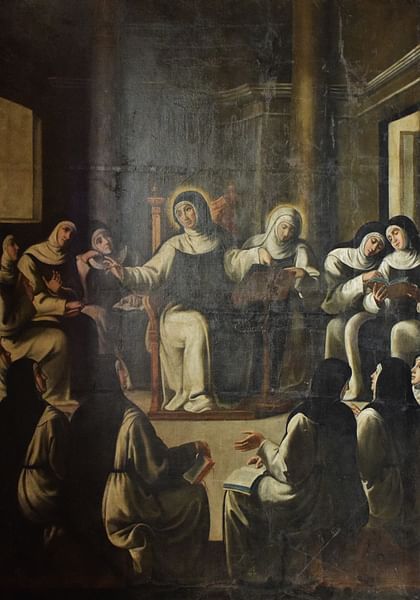
Saint Paula
Melania the Elder (l. c. 350-410 CE) was a Desert Mother honored for her devotion to God and support of Christian orders. She was a member of 1 of the wealthiest families in Roman Hispania who moved with her proconsul husband and family back to Rome simply to watch all but 1 son die of the plague. Subsequently losing her family, she converted to Christianity and renounced the world, traveling to Egypt to live in a monastery. Unlike other Christian converts, Melania did non give abroad her worldly goods and used her substantial wealth to support Christian communities and initiatives. When the monks of her order were exiled to Palestine, she went with them and supported them until they could render. She founded ii monastic orders in Jerusalem, which she administrated, and is regarded as a Desert Mother for her strict asceticism and devotion to solitary prayer.
Eudocia (l. c. 400-460 CE) was one of the well-nigh prolific writers of her time who created numerous works on Christian themes which, like Proba'south piece of work, drew on pre-Christian literature. She was born in Athens and named Athenais before converting to Christianity around the age of 20 and taking the name Aelia Eudocia following her baptism. Her works were quite popular and ranged from a cento drawing on Homer to poetry about her husband's life and military victories, to saints' lives and Church building history. She is probably best known for her work The Martyrdom of St. Cyprian which tells the story of the chaste Christian Justa, the attempts by the pagan sage Cyprian to seduce her, his conversion to Christianity, and martyrdom for his faith.
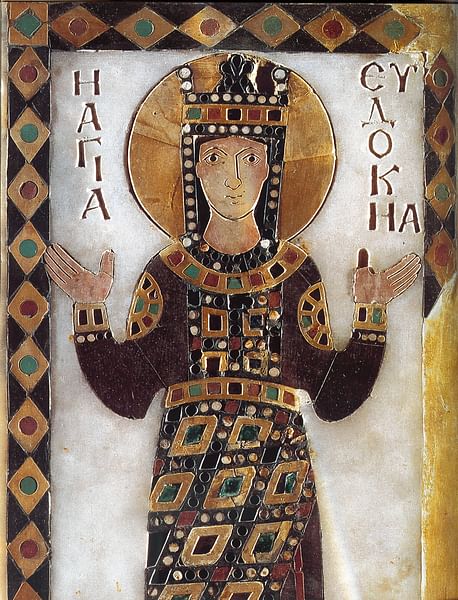
Aelia Eudocia
Egeria (besides known every bit Etheria, l. c. 380's CE) was a Christian traveler and writer known only from her work Itinerarium (too known as the Itinerarium Egeriae = Travels of Egeria). Based on the text, she was a woman of the upper class who went on pilgrimage to pregnant sites mentioned in the Bible. She traveled through the regions of modern-24-hour interval Turkey, Egypt, State of israel, Lebanon, Jordan, Syria, Republic of iraq, Iran, Kuwait, Saudi Arabia, and dorsum to the region of Anatolia. Her work was popular enough to be copied and is recognized in the mod-day as completely unique for its fourth dimension as information technology is a deeply personal account of Egeria'due south travels while as well providing insight into the condition of the sites she visited, travel at the time, and – since information technology is written in Latin – how that linguistic communication was written at the fourth dimension.
Conclusion
The contributions of these women were recognized by their male contemporaries who included accounts of their lives in their works on male person saints. Amma Syncletica was so highly regarded she was given her ain biography, and Saint Jerome praised Paula in his works. The works of Proba and Eudocia seem to have been widely read, judging from copies, and even though Egeria's work was not discovered until the 19th century CE, information technology was recognized so equally appearing in extract form in other works from shortly after her time.
Why these women were erased from official Church history is debated past diverse scholars with the reply always depending on the political, religious, or gender values of the writer making the claim. In well-nigh every case, the arguments in these debates say far more than about the modern-day author than they do about the subject at hand. Scholar Laura Swan, however, sums upward the state of affairs succinctly, writing:
Women's history has ofttimes been relegated to the shadow earth: felt merely non seen. Many of our Church fathers became prominent considering of women. Many of these fathers were educated and supported by potent women, and some are even credited with founding movements that were actually begun by the women in their lives. (3)
As the Church developed from its legitimization by Constantine through the Centre Ages, women lost more than and more basis in equal rights and basic dignity. The medieval Church considered women dangerous temptresses to be avoided past whatever pious human, stained past the original sin of duplicitous Eve, and fifty-fifty their clan with the Virgin Mary could not fully redeem their nature. The most probable cause for the exclusion of women of bully merit from Church history is merely that they did not fit the Church's narrative of devout and pious men vs. devious, sinful women and, when faced with the choice of changing that narrative or changing history, the past was quietly erased.
This article has been reviewed for accuracy, reliability and adherence to bookish standards prior to publication.
Source: https://www.worldhistory.org/article/1409/ten-should-be-famous-women-of-early-christianity/
0 Response to "Woman German Scholar Who Became Born Again"
Post a Comment